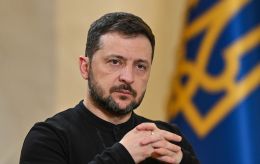Why Kyiv is under fire: Expert explains Russia's missile tactics
 Photo: Aftermath of the June 23 attack in the Shevchenkivskyi district of Kyiv (Vitalii Nosach/RBC-Ukraine)
Photo: Aftermath of the June 23 attack in the Shevchenkivskyi district of Kyiv (Vitalii Nosach/RBC-Ukraine)
Russia deliberately targets Kyiv during combined massive attacks using missiles and drones. The capital has always been a strategic target in wartime, and there are several reasons for that, Oleksandr Musiienko, Head of the Сenter for Military Law Research, an analyst and an expert, says in a comment to RBC-Ukraine.
Why Russia targets Kyiv
"First, in any war, the capital always receives heightened attention from the enemy. Think back to World War Two - London was bombed by the Nazis, not other cities," Musiienko said.
According to Ukrainian expert, this is because a capital is always a center of political and business life. It houses government institutions, so-called decision-making centers, which Russia is constantly obsessed with targeting, as promoted by Russian propaganda.
"In addition, Russian war criminals believe that if they break the resistance and will to fight among the population of the capital, it could trigger a domino effect, a house of cards collapse, demoralizing other regions and cities," Musiienko added.
Another possible reason for Russia's focus on Kyiv, according to the analyst, could be the search for critical facilities, including manufacturing sites.
"The enemy may assume that because Kyiv has more air defense systems or government agencies, some sensitive production facilities may be located there under protection and worth striking," Musiienko explained.
Still, the main reason lies in the terrorist objective: to demoralize the population, spread fear and panic, and ensure it spreads to the rest of Ukraine.
"That's why we're seeing most of the current strikes aimed at Kyiv - this is backed by statistics," an analyst added.
How Russia's approach to strikes evolves
The expert noted that Russia is constantly adjusting its tactics, searching for ways to overload Ukraine's air defense systems, using various weapons and launching attacks from different directions.
However, Musiienko stressed that the sequence of attacks - starting with drones, followed by ballistic missiles, then again drones and missiles - does not make much difference, because Ukraine employs a differentiated air defense system. There are areas of responsibility for certain assets involved in repelling attacks.
"For example, aviation can operate in its own sectors, anti-aircraft weapons operate for other purposes, Patriots operate to shoot down ballistic missiles, and so on. Therefore, each type of weapon has its own defining role," an analyst said.
Nonetheless, Russia continues testing combinations it believes might allow them to bypass Ukrainian air defenses and inflict greater destruction.
When can next massive attack happen
The last massive missile-drone attack on Kyiv occurred on Monday, June 23. Before that, the city was struck on June 18 and June 9.
The two latest attacks were especially deadly and cynical. On June 18, a missile strike on a residential nine-story building in the Solomianskyi district killed 23 people. Less than a week later, on June 23, a missile hit a five-story building in the Shevchenkivskyi district, killing nine.
Musiienko noted that the June 18 attack involved a larger number of airborne weapons, including more drones and missiles, while the June 23 attack saw fewer used.
"So, there's no trend toward escalation. Moreover, the war between Israel and Iran has impacted Russia's drone capabilities. Iran has been more focused on that conflict and less on supporting Russia. Putin is trying to compensate by involving North Korean labor and supplies from China, but that still had an impact on Russia's capabilities," the Ukrainian military expert explained.
However, the aggressor still continues to produce drones and will accumulate them, the analyst noted.
"If we're talking about the end of this month, the enemy could potentially launch another attack, but not exceeding what we saw on June 23," Musiienko predicted.
On June 23, Russia launched another combined attack on Ukraine, using drones as well as ballistic and cruise missiles. Kyiv and the Kyiv region suffered the most.
According to the State Emergency Service, buildings in five districts of Kyiv were damaged. In Shevchenkivskyi district, a missile struck a high-rise residential building, causing an entire entrance to collapse. Interior Minister Ihor Klymenko stated that preliminary information indicates a ballistic missile pierced the building all the way to the basement.
Among the victims were an 11-year-old girl and her mother. In total, nine people were killed and 34 wounded.
In the Kyiv region, another person was killed. Eight others were injured, including two rescuers who were caught in a repeat strike.
Prosecutors have opened a criminal case under the article on violations of the laws and customs of war, resulting in civilian deaths.

